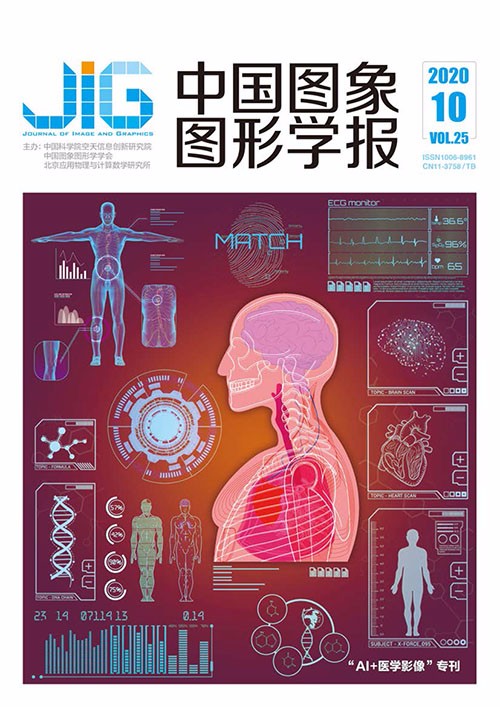
超级计算支撑的新冠肺炎CT影像综合分析辅助系统应用
康波1,2, 郭佳2, 王帅3, 徐波3, 孟祥飞2(1.天津大学智能与计算学部, 天津 300350;2.国家超级计算天津中心, 天津 300457;3.天津医科大学附属肿瘤医院, 天津 300060) 摘 要
目的 新冠肺炎(COVID-19)已经成为全球大流行疾病,在全球范围数百万人确诊。基于计算机断层扫描(computed tomography,CT)数据的影像学分析是临床诊断的重要手段。为了实现快速高效高精度地检测,提出了一种超级计算支撑的新冠肺炎CT影像综合分析辅助系统构建方法。方法 系统整个处理流程依次包括输入处理模块、预处理模块、影像学分析子系统和人工智能(artifiaial intelligence,AI)分析子系统4部分。其中影像学分析子系统通过分析肺实变、磨玻璃影和铺路石等影像学典型特征检测是否有肺炎和典型新冠肺炎特征,给出肺炎影像分析结论;AI分析子系统通过构建深度学习模型来区分普通病毒肺炎与新冠肺炎,增加肺炎的筛查甄别能力。结果 系统发布以来,持续稳定地为国内外超过三十家医院与一百多家科研机构提供了新冠肺炎辅助诊断服务和科研支撑,为抗击疫情提供重要支撑。结论 本文提出的超级计算支撑的新冠肺炎CT影像综合分析辅助系统构建方法,取得了应用效果,是一种有效实现快速部署服务、对突发疫情提供高效支撑的服务方式。
关键词
Supercomputing-supported COVID-19 CT image comprehensive analysis assistant system
Kang Bo1,2, Guo Jia2, Wang Shuai3, Xu Bo3, Meng Xiangfei2(1.College of Intelligence and Computing, Tianjin University, Tianjin 300350, China;2.National Supercomputer Center in Tianjin, Tianjin 300457, China;3.Tianjin Medical University Cancer Institute and Hospital, Tianjin 300060, China) Abstract
Objective The Coronavirus Disease 2019 (COVID-19) has become a global pandemic, causing millions of people to be infected worldwide. Imaging analysis based on computed tomography (CT) data is an important means of clinical diagnosis. A supercomputing-supported method is proposed for the construction of a new comprehensive CT analysis auxiliary system dealing with pneumonia. Method The system consists of four parts: input processing module, preprocessing module, imaging analysis subsystem, and artificial intelligence(AI) analysis subsystem. Among the four parts, the imaging analysis subsystem detects the pneumonia features, distinguishes typical new coronary pneumonia by analyzing the typical imaging features, such as lung consolidation, ground-glass opacities, and crazy-paving pattern, and then comes to a conclusion of pneumonia. The AI analysis subsystem uses a deep learning model to classify typical viral pneumonia and COVID-19, which enhances the screening ability of pneumonia. Convolutional neural network is widely used as an effective algorithm for medical image analysis, particularly in image classification. It is also widely utilized in the CT image screening and has achieved good results, which has attracted the attention of domestic and foreign scholars and industry. The seasonable result derived from deep learning relies largely on the number and quality of training samples. Given the lack of training samples, the system selects transfer learning as the technical direction for model construction. Considering the quick response to the epidemic, the quality of easy maintenance and dynamic system updating is required. Thus, after comparing and analyzing the performance and classification effect indexes of many common image classification models, we build a transfer learning neural network model on the basis of inception. The entire neural network can be roughly divided into two parts: the first part uses a pre-trained inception network; the role of which is to convert image data into a one-dimensional feature vector. The second part uses a fully connected network to improve classification prediction. The imaging analysis method analyzes the image features of COVID-19, extracts the pneumonia feature areas, and carries out semantic analysis to achieve the delineation of the pneumonia target area. Simultaneously, the typical imaging characteristics of COVID-19 (such as ground glass shadow, infiltration shadow, and lung consolidation) are targeted. With regard to the pneumonia target area, a multi-level dynamic threshold segmentation is first used to determine the minimum lung tissue area (rectangular region of interest (ROI)). The extraction of the lung tissue area is designed as a normal workflow. For each ROI, pixel statistics, threshold segmentation, regional dissolution and expansion, and abnormal proofreading are used to obtain the pneumonia target area. Aiming at the relationship between the sizes of the pneumonia target area, a logical filter is established to detect the segmented distribution features and spatial relationship with the outer contour of the lung. Then, based on the characteristic relationship of typical new coronary pneumonia, the typical characteristics of new coronary pneumonia are outlined. The entire comprehensive analysis platform is built on the basis of the Tianhe artificial intelligence innovation-integrated platform. The Tianhe artificial intelligence innovation-integrated platform is based on the hardware fusion supporting the environment of Tianhe supercomputing, cloud computing, and big data, upon which realizes the existing mainstream deep learning framework. It is highly encapsulated with the processing model algorithm, forming a visual interactive template development environment covering multiple links such as data loading, model construction, training, verification, and solidified deployment. As a service on this supporting platform, CT image comprehensive analysis AI auxiliary system has access to the computing resources, data resources, and external service capabilities of the platform and finally achieves the rapid integration and dynamic update of the system during the pandemic. Result After its release, the system has continuously and steadily provided new COVID-19 auxiliary diagnostic services and scientific research support for more than 30 hospitals and more than 100 scientific research institutions at home and abroad, providing important support for combating the epidemic. Conclusion The supercomputing-supported new coronary pneumonia CT image comprehensive analysis auxiliary system construction method proposed in this paper has achieved important application on diagnosis and research. It is an effective way to achieve rapid deployment services and provide efficient support for emergencies. The system applies artificial intelligence technology using CT imaging to screen for COVID-19. By applying artificial intelligence to the screening of COVID-19 with pneumonia and giving reference opinions for auxiliary diagnosis, the marking and area statistics of the inflammatory regions are improved. The system achieves the combination of artificial intelligence traditional machine vision and deep learning technology to distinguish COVID-19 by using CT images. The combined route of viral pneumonitis feature extraction based on traditional machine vision and the COVID-19 image classification based on artificial intelligence technology has achieved a comprehensive analysis of medical image features and COVID-19 screening. The fast implementation mode of the fusion platform scenario is based on computing power and data support. Relying on the Tianhe artificial intelligence innovation-integrated service platform, the platform supports intelligent frontier innovation on the basis of computing power and data, implements an open model of simultaneous research and application, and has a multi-industry training resource model library and large-scale distributed training sources. With regard to rapid deployment and other service capabilities, this comprehensive analysis system is also the first public COVID-19 AI-assisted diagnostic system deployed online. Analysis based directly on digital imaging and communications in medicine(DICOM) data and video data will effectively improve the analysis efficiency, but it will involve data ethics and security-related issues; however, it is the developing direction that needs to be resolved in the future.
Keywords
Coronavirus Disease 2019(COVID-19) computed tomography(CT) imaging auxiliary diagnosis artificial intelligence(AI) supercomputing
|



 中国图象图形学报 │ 京ICP备05080539号-4 │ 本系统由
中国图象图形学报 │ 京ICP备05080539号-4 │ 本系统由